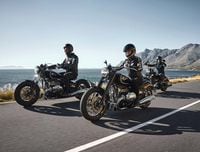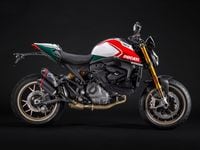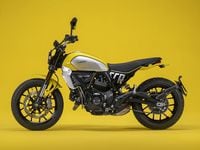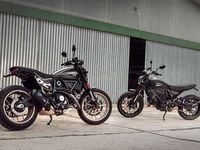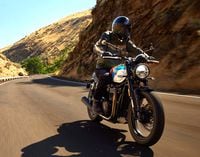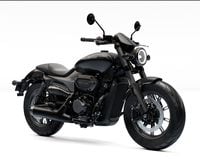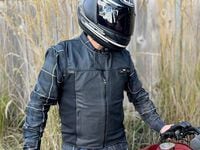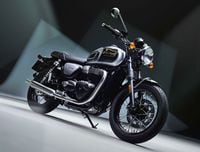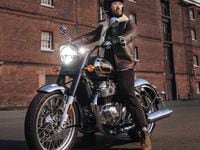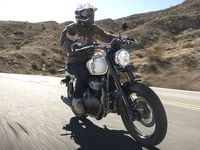First Ride!
Just before I left for New Orleans to try the new Bonneville, I had an amusing conversation with a friend about the redesigned bike. The central topic was this: How could a bike whose entire appeal is nostalgia be "new?" We joked how the new one might look even older than the last, or how a new paint treatment adds a authentic-looking patina to the metal. When Triumph proclaims that they're launching an all-new Bonneville, they've painted themselves into a corner haven't they? I mean, what are they going to do, make it look more like the 1960s?
Not exactly. It was more of a diversification than a redesign. The new entry-level Bonny has ergonomics slightly tweaked to fit smaller riders, and sportier 17-inch cast rims (with radial rubber to match) that make for a lighter-handling machine. Smartly, the new rubber is wider up front for a better footprint and stays skinny at the back for quicker turn-in; ignoring the irrational wide-tire craze. If you liked the old new Bonneville (as opposed to the old Bonneville) you can still score that layout on the chromed-out T100, complete with wire rims. In essence, the T100 is inspired more by the 1960s while the Bonneville is more 1970s. (For a complete list of differences between Bonneville and T100 see sidebar)
Going into this reboot, the Triumph designers knew they needed to be careful. But with the model's 50th anniversary coming they knew whatever they did needed to be significant. So fast-forward to the 70s, with a dash of the 21st century for good measure. For 2009, all of the 865cc twins in Trumph's ModernClassic range (as well as the cruisers based on the same powerplant) got electronic fuel injection. However, the carbs behind the parallel twin heads was as much of a Triumph trademark as the distinctively shaped gas tanks or even its triangular badge. So when it came time to upgrade to EFI for both performance and ecological reasons, Triumph worked with Keihin to design an injector housing that looked for all appearances to be a CV-style carburetor. Very slick idea, but why they didn't take it all the way back to a round-bodied vintage-style carb, we're not sure. The new system is a thoroughly modern closed-loop setup, which should automatically compensate for elevation and air mass differences.
Since the T100 was no longer a true trim upgrade from the Bonneville, but more truly another model, a high-spec Bonneville was needed. Enter the Bonneville Special Edition. Sporting the same wheel and ergo package as the standard version, the SE gets a tachometer, two-tone paint, brushed-aluminum engine cases, and a chromed cast tank badge to the base model's sticker.
Unlike most of these new model launches, we actually got to put some real miles on the new Bonny. After our pre-packaged group ride through the bayous of Mississippi, we spent another couple days exploring the back roads and city streets of greater New Orleans. The Bonneville was the perfect companion for a job like this.
Settling in to the compact cockpit, the Bonneville has a very upright seating position, but only a little cramped for my 6-foot frame. Adjustable levers for both clutch and brake are a very nice touch, especially on a bike at this price. With a twist of the key, it fires right up and settles into the even gait of a parallel twin. Though it has an enrichener knob (or choke), I never needed it to start the bike. Possibly it's just there to complete the carb-equipped illusion, but Triumph representatives say it's for starting in extreme cold.
Starting in downtown New Orleans, adjacent to the French Quarter, gave a quick taste of city riding. The new sprightly character of the Bonneville is immediately apparent, and very much at home in the city, the new wheels not only reduced spinning mass, but also dropped the rake and trail numbers slightly as well. It's a light-feeling machine that flicks in and around traffic with ease, yet has a huge spread of midrange torque to accelerate quickly at most rpm. The Bonny is no power-monger, but neither is it left wanting. While it's nice to have the tach on the Special Edition version, you don't really need it; once out of the uninspiring bottom end, the parallel twin revs and revs to a sky high redline, leaving plenty of room for error. Shifting is silky smooth, with a five-speed gearbox that moves easily between cogs. Suspension is solid for a semi entry-level bike; you feel the big hits and there's some bouncing in the rough stuff, but under most normal conditions it's a champ.
Out in the country, piling on miles, it's more of the same. The Bonneville is a very instinctive bike to ride, extremely neutral handling at all speeds. As speeds increased, the suspension that worked so well in the city retained its composure. We got to ride the other Modern Classics from Triumph's line as well, including the T100 (see sidebar) and the Thruxton. Surprisingly, the Bonneville is arguably a better handling machine than the Thruxton, which retains vintage-style wire wheels. Though the Thruxton puts its rider in a more aggressive position and is a stable sporting machine, the Bonny out-flicks it in the corners. Ground clearance is excellent, and perfectly adequate for all but the sportiest riders. Though the seat looks mostly unchanged from the bench seats of yesteryear, it has a subtle dished out section that makes it comfortable for lots of miles and smiles.
Over next couple days we tooled around the bayous and byways of the lower Mississippi Delta, on a Special Edition equipped with saddle and tank bags, racking up a few hundred miles in the process (look for the story in a couple of issues). Despite having about 70 pounds of gear strapped to it, loads of stop-and-go city riding, and high-speed backroad bombs, the Bonneville SE still managed 47 mpg. Despite my initial feeling that the bike is on the small side for me, I suffered no ill effects of the tight cockpit, and felt very at home on the bike by the time I gave it back.
Like Yamaha's recent V-Star 950, the Bonneville is yet another entry level bike that feels like a finished, complete piece; not some pricepoint-oriented cheapie. It's got abundant, but non-threatening, power across a wide range, and manages to be a fun, satisfying ride. Smaller riders will be thrilled with the new ergo package, and while the seat height is a moderately high 29.1 inches, the bike is narrow across the midsection and very light-feeling. The new Bonny is an excellent choice for riders old and new, whether on a budget or just starting out.
2009 Triumph Bonneville/Se
MSRP: $7699/$8399
Colors: Base: white, black SE: black, blue/white two-tone
**Engine **
Type: Oil-cooled parallel twin
Displacement, Bore And Stroke: 865cc, 90mm x 68mmValve Train: SOHC, 4 valves per cylinder
Compression Ratio: 9.2:1
Fuel System: EFI, dual 36.5mm throttle bodiesTransmission/Final Drive: 5-speed, belt final drive
Chassis
Front Suspension: 41mm telescopic fork, 4.7 in. travel, non-adjustable
Rear Suspension: twin shocks, 3.9 in. travel, preload adjustable
Front Brake: Single 310mm disc
Rear Brake: 255mm disc
Front Tire: 110/70-17
Rear Tire: 130/80-17Wheelbase: 58.5 in.
Rake/Trail: 27-degrees/4.2 in.
Seat Height: 29.1 in.
Fuel Capacity: 4.2 gal.
Weight: 440 lbs (dry, claimed)
Performance
Horsepower: (claimed, @ crank): 67 hp @ 7500 rpm
Torque: 51 lbs.-ft. @ 5800 rpm
Fuel Mileage: 47 mpg average
Bonneville Or T100?
We had the chance to ride the T100 briefly, and by comparison to the Bonneville, it feels like a bigger bike, though the only non-aesthetic differences are larger, heavier wheels and ergonomics. But with these two differences, a more spread-out cockpit (though only by a little bit), larger grips, and increases steering effort make it a bike you have to more firmly push into a corner. Sound from the peashooter mufflers is a little more throaty than the megaphones on the Bonny. Personally at 6-foot-nothing, 190 lbs, I'd prefer the T100's ergs with the Bonny's handling.
T100
19" (front) 17" (rear) Laced wheels bias-ply tires
Traditional banana seat.(30.5" seat height)
Pea Shooter mufflers
Standard Tachometer
Chrome finished cases, rubber fork gaiters and kneepads.
Bonneville
17" cast wheels with Metzeler MEZ4 radial tires.
Sculpted seat (29.1" seat height)
Reverse Megaphone (a la Thruxton) mufflers
Tach only standard on Special Edition










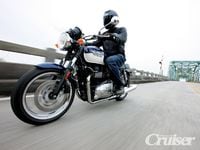
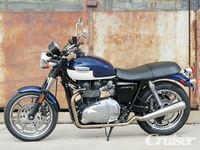
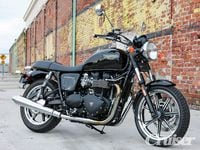
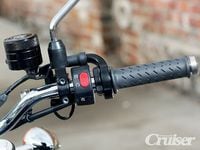
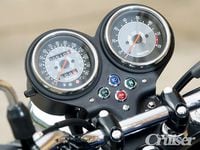
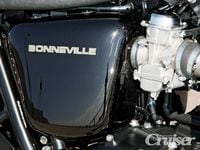
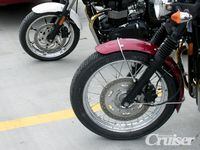
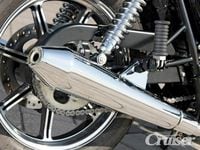
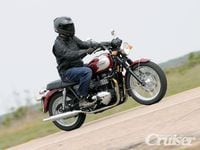
/cloudfront-us-east-1.images.arcpublishing.com/octane/H6Z2IC7WYRBXZNQS4MI3SZ5KPQ.jpg)
/cloudfront-us-east-1.images.arcpublishing.com/octane/IWO5T5PBT5E4HFQ5GK47H5YXR4.jpg)
/cloudfront-us-east-1.images.arcpublishing.com/octane/OQVCJOABCFC5NBEF2KIGRCV3XA.jpg)
/cloudfront-us-east-1.images.arcpublishing.com/octane/F3O2DGLA4ZBDJGNVV6T2IUTWK4.jpg)
/cloudfront-us-east-1.images.arcpublishing.com/octane/ZXYQE3MHLFDSPKNGWL7ER5WJ4U.jpg)
/cloudfront-us-east-1.images.arcpublishing.com/octane/RDF24VM7WVCOBPIR3V3R4KS63U.jpg)
/cloudfront-us-east-1.images.arcpublishing.com/octane/W7RSIBFISNHJLIJESSWTEBTZRQ.jpg)
/cloudfront-us-east-1.images.arcpublishing.com/octane/AERA26ENRNBW3K324YWCPEXYKM.jpg)
/cloudfront-us-east-1.images.arcpublishing.com/octane/YWX3YX7QBBHFXFDMEEEKRG4XJE.jpg)
/cloudfront-us-east-1.images.arcpublishing.com/octane/I7OKI53SZNDOBD2QPXV5VW4AR4.jpg)
/cloudfront-us-east-1.images.arcpublishing.com/octane/IH52EK3ZYZEDRD3HI3QAYOQOQY.jpg)
/cloudfront-us-east-1.images.arcpublishing.com/octane/K2FSAN7OWNAXRJBY32DMVINA44.jpg)
/cloudfront-us-east-1.images.arcpublishing.com/octane/G4XK7JL24FCUTKLZWUFVXOSOGE.jpg)
/cloudfront-us-east-1.images.arcpublishing.com/octane/JJNXVAC27ZCDDCMTHTQZTHO55Y.jpg)
